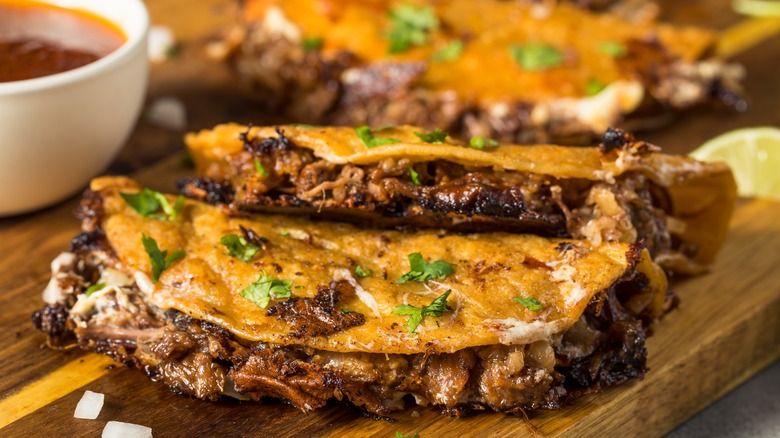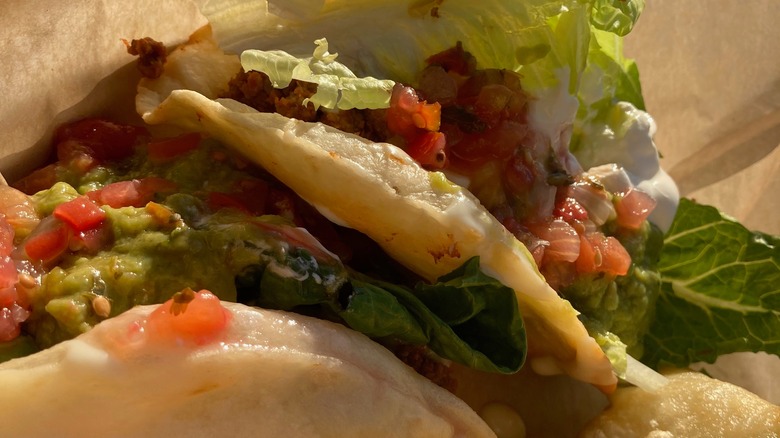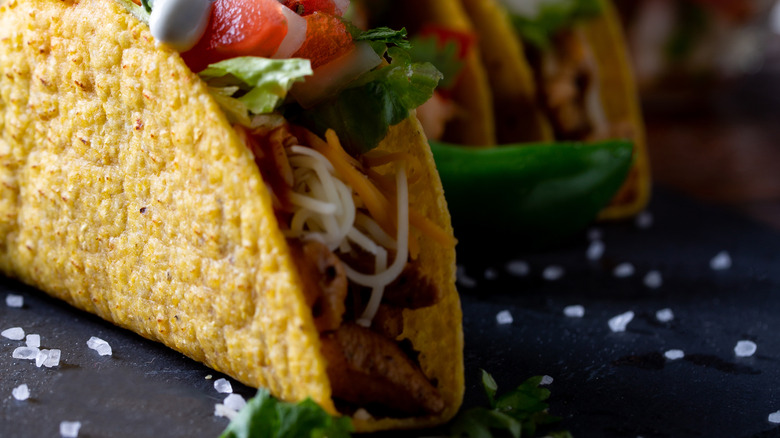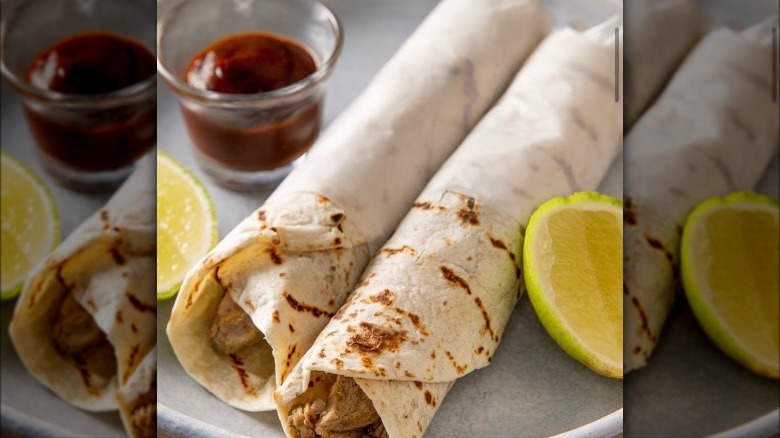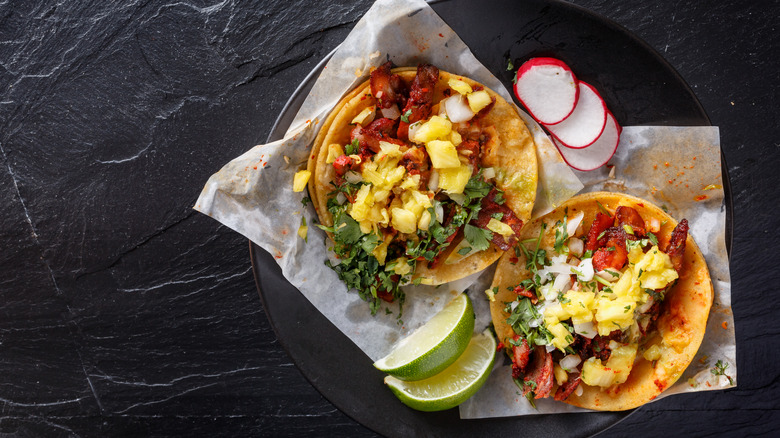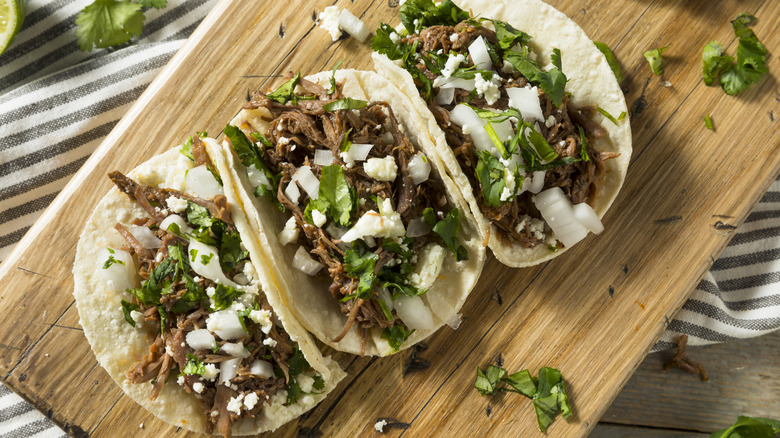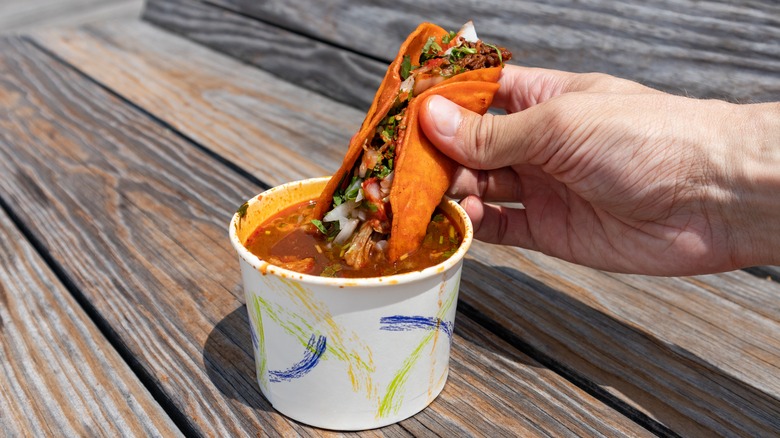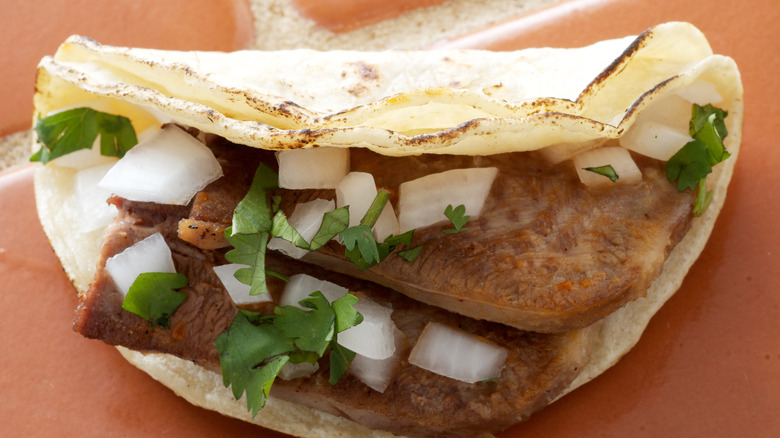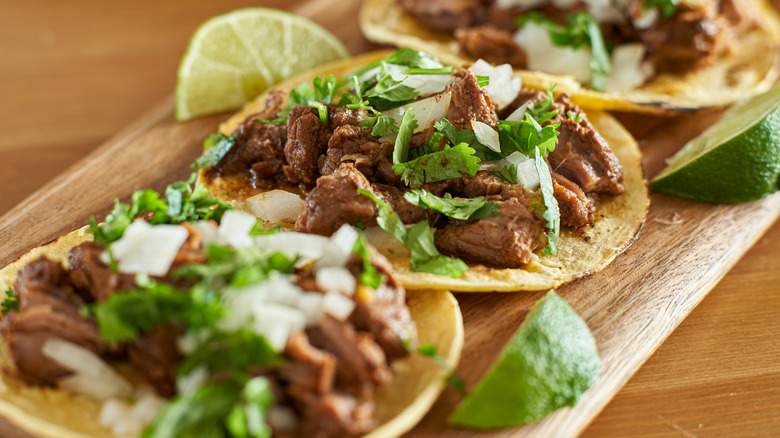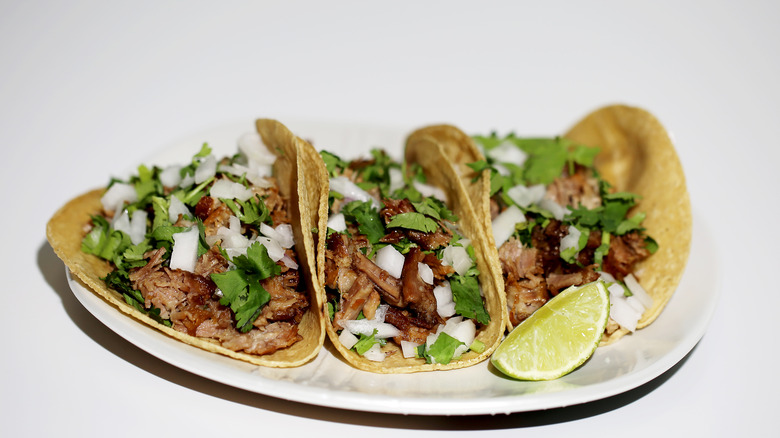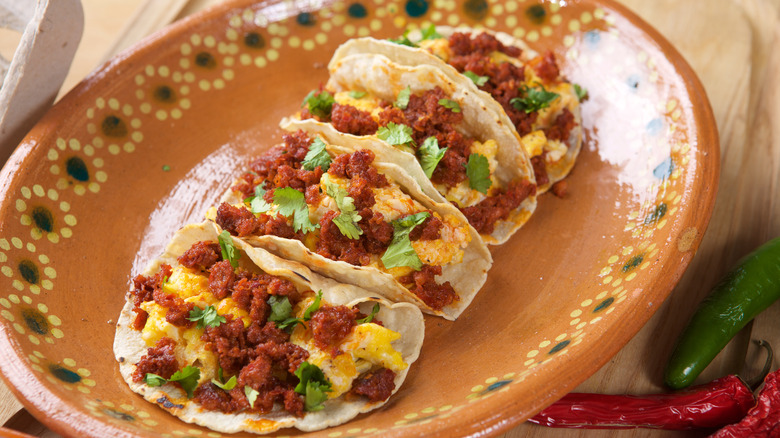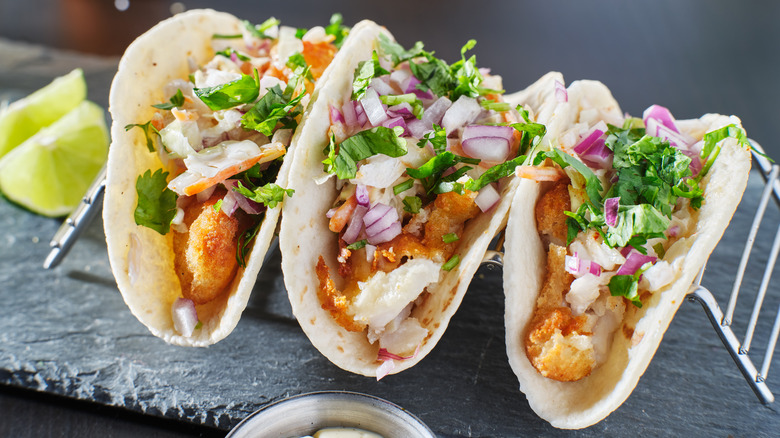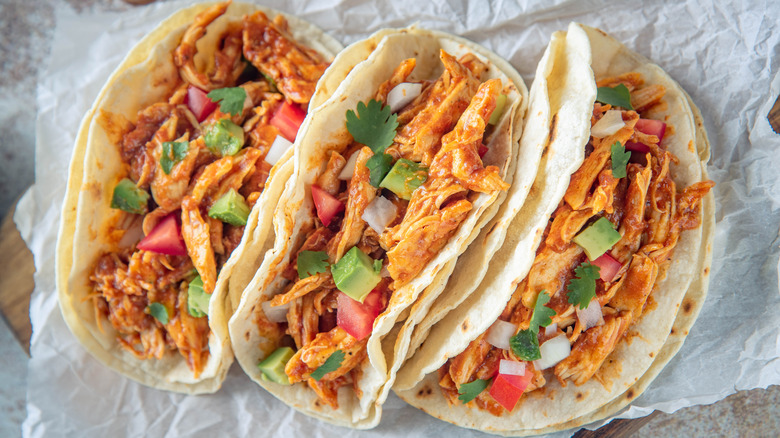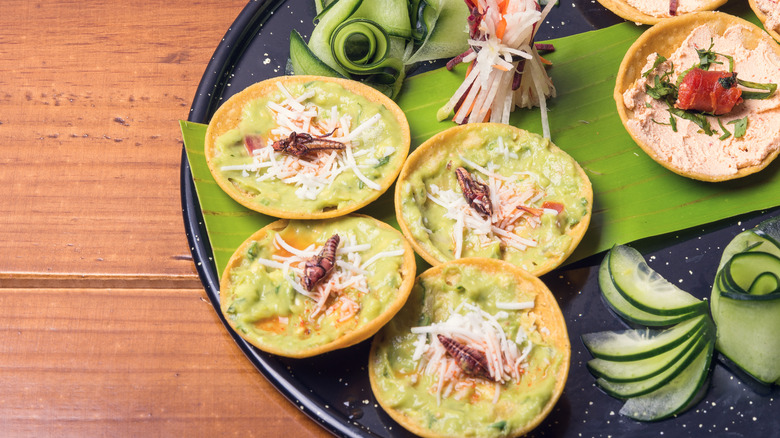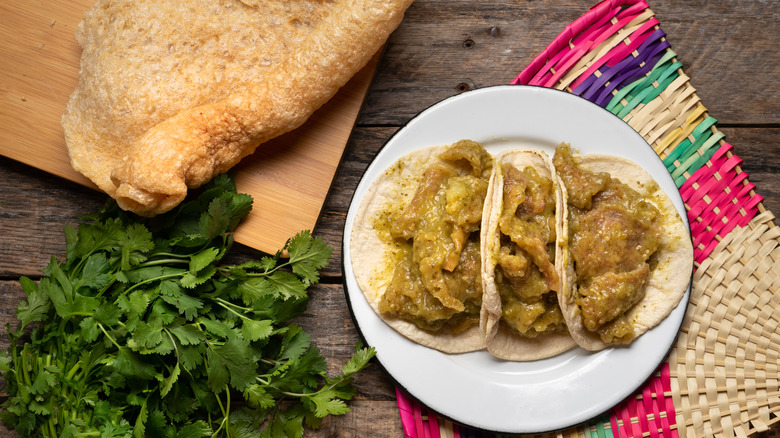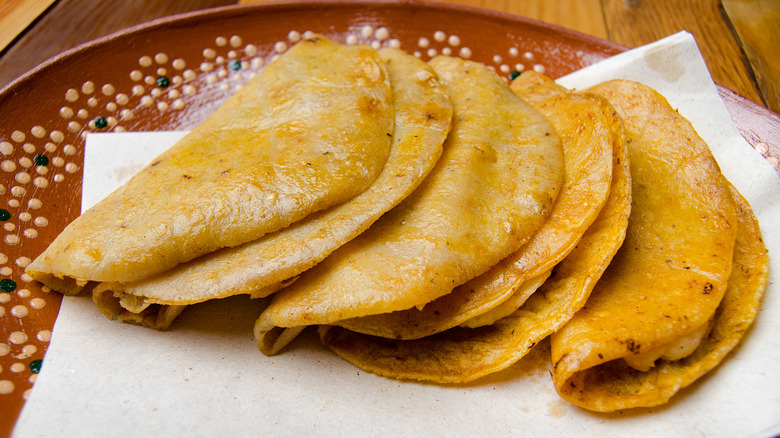15 Types Of Tacos, Explained
It's hard not to love tacos, but did you know there is more to the decadent, savory layers of meat, toppings, and tortilla than you think? There are many different varieties of tacos, but the humble street food traces its origin back to a singular country: Mexico. According to Smithsonian Magazine and taco historians like Jeffrey M. Pilcher, the "taco" likely originated in Mexican silver mines in the 1700s. "Taco" was the word for the charges used to pull ore from the rock faces; the taquito, which is a small taco wrapped in a corn-based tortilla, bears a resemblance to the tacos from the mines (via Uno Casa). It seems fitting that the first written use of "taco" appeared in the late 1800s as "tacos de minero" — miner's tacos.
The definition of a taco has been adapted over the years to suit the ingredients and flavors brought by migration to-and-from Mexico, as well as a changing taste for flavors and textures. Here are some of the major types of tacos you may see sold by taco trucks, Mexican taquerias, and every place in between.
Puffy tacos
Puffy tacos were created initially by accident, but have since defined San Antonio's taco community. In the early 1900s, Maria Rodriguez Lopez, a grandmother in San Antonio, was frying tostadas in her kitchen and accidentally dropped the skewer she was using to flip the tostada. Maria left the skewer in the oil longer than intended, which in turn caused the dough to puff up around the skewer. Eventually, the recipe for making these tacos — which were known before the 1970s as "crispy tacos" — became a staple at Maria's family's restaurant, Ray's Drive Inn. After some debate in ownership over the puffy taco, it became generally associated with the San Antonio taco scene.
The key to making puffy tacos is using fresh masa, not masa harina. Fresh masa renders the taco's exterior snappy and crisp while keeping the inside soft and plush. The puffy taco is prepared with ground beef or shredded chicken for protein, avocado, and veggies like lettuce and tomatoes. Moreover, the key to the puffy taco is eating it as soon as it is prepared so it does deflate or get too soggy.
Fast-food taco (hard taco)
The hard shell taco, otherwise known as the fast-food taco, is an Americanized version of taco preparation. In Mexico, tacos are almost exclusively made with corn and left soft rather than being baked or fried. Hard tacos, which are usually baked or deep-fried into a stuffable U-shape design, are descendants of the Mexican tacos dorados — which are soft tacos stuffed with a filling before being fried. In the 1930s, inventor George Ashley made a taco fryer capable of cooking more than 600 shells an hour (via MEL Magazine). He eventually began selling metal taco molds for DIY-ing hard tacos at home, which was one of the first separations between frying the taco shell separately from its contents.
Glen Bell, the owner of the Taco Bell chain, was inspired to engineer a mass-produced hard taco (which he termed the "crunchy taco") after observing another area taco stand — Mitla's Cafe in San Bernardino, California (via Taco Bell). Bell eventually went on to open hundreds of restaurants within the United States and globally, pitching the same crunchy hard taco with almost any filling imaginable.
Tacos árabes
According to Eat Mexico, the first tacos árabes appeared in Puebla, Mexico in the 1930s. The recipe for tacos árabes was the product of the economic-driven migration of Lebanese people to the Mexico City region. The original recipe featured spit-roasted lamb seasoned with a salt-based blend rather than a marinade. These tacos are served on a flour tortilla rather than a corn tortilla, which is similar to the Lebanese roast lamb shawarma served on pita bread. There was a synergy between Lebanese and Mexican cuisines that grew over time, especially after purveyors started adding Mexican lime juice and chipotle salsa to the taco. Tacos árabes are also considered the foundation for tacos al pastor.
But some things haven't changed — including the addition of a spicy chipotle salsa that replaced the Mediterranean seasoning blend of caraway, cardamon, nutmeg, and ginger traditionally used for shawarma. The reason for this change was the limited availability of spices when the Lebanese immigrants arrived in Mexico.
Tacos al pastor
Tacos al pastor are the decedents of tacos árabes. Besides the succulent pork shoulder replacing the traditional lamb, al pastor tacos have also evolved to include the addition of sweet pineapple as a topping. The pineapple provides a unique tang to the pork and provides a bit of relief from the pork's spice blend which includes salt, oregano, cumin, garlic, and chipotle powder.
The pork for tacos al pastor is usually made by spinning pork shoulder on a trompo — a rotating piece of metal that keeps the meat juicy and tender on the inside, and slightly crispy on the outside. The meat is thinly shaved with a knife before being tossed onto the soft tortilla and served with cilantro, lime, and cubed pineapple pieces. The distinguishing characteristic of this taco is its fatty flavor that comes from the fat dripping down the pork shoulder as it cooks, so you shouldn't expect to see cuts of meat other than pork shoulder in a proper taco al pastor.
Tacos de barbacoa
Barbacoa is a Caribbean-style meat preparation that traditionally involved wrapping meat in leaves and burying it in a hot stone pit for several hours. Eventually, this technique of preserving and cooking meats traveled to Mexico where the meat was coated in sauces made from chili peppers, spices, and chocolate, which eventually became known as molé.
Barbacoa can be made with beef (which is most popular in America), goat, lamb, or mutton. The nature of cooking for long periods of time means that barbacoa usually used large cuts of meat with connective tissues — which can break down with time and infuse flavor into the meat. The meat is usually flavored with a rub of dried guajillo, Mexican oregano, and ancho chili peppers, but each barbacoa chef may add their spin to the seasoning. The most common accompaniments for tacos de barbacoa include chopped white onions, cilantro, and a twist of lime juice.
Tacos de birria
Birria embodies the definition of juiciness and flavor. Unlike barbacoa, birria originated from Jalisco, Mexico, and is cooked by submerging the meat (which is traditionally goat) into a thick sauce with adobo, onions, tomatoes, and peppers. The tacos are prepared by soaking the tortillas in the adobo liquid, cooking them on a flat top, and filling them with the delicious stewed beef. Birriras are usually sold with a side of the cooking liquid and a topping of freshly chopped onion and cilantro.
The taco was introduced to Tijuana, Mexico with Don Guadalupe Zárate's taco stand, which modified the taco to use beef instead of goat and add more liquid in the broth. The tacos were eaten as breakfast food until the 2000s when Mexican-American brothers Omar Gonzales and Oscar Gonzalez, as well as Teddy Vasquez, brought the birria recipe to Teddy's Red Tacos in Los Angeles. Their offerings included the traditional juicy birria taco, as well as quesabirrias: birria tacos filled with cheese.
Tacos de cabeza
Legal Nomads notes that tacos de cabeza were the product of Spanish influence; beef and pork were both brought to the New World with the arrival of Spanish conquistadors. The word "cabeza" means anything related to the head of the animal. The meat is usually split into two parts: the "maciza" (solid meat) and the offal (soft meat). The offal can mean anything from the eyes, tongue ("lingua"), brains, sweetbread, or beef intestine ("machitos"). Together, both of these cuts of meat are termed "surtido" (via Legal Nomads).
Tacos de cabeza is usually prepared by steaming the head of the animal overnight and shredding it in the morning; it can also be added back to its cooking juices (consommé). The exact flavoring of the meat is dependent on the cut, but beef is often simmered with achiote (annatto), peppercorns, and avocado leaves before being folded into a tortilla with chopped cilantro and crunchy raw onions.
Carna asada tacos
The base of the carne asada taco is thinly sliced marinaded beef. This Mexican meat preparation technique is usually made from a skirt or flank steak, both of which are relatively inexpensive and easy to slice. The steak is marinaded with a blend of jalapeño, garlic, lime juice, oil, vinegar, and cilantro before being grilled and rested. A key part of the perfect carne asada flavoring is the use of mesquite. The mesquite tree is common firewood in Mexico and the Southwestern United States because the wood imparts dark, smoky notes on the meat. After the carne asada is finished grilling, the steak is then sliced thinly, placed on a corn tortilla, and topped with fresh lime wedges, avocado, salsa, and cilantro.
According to Backyard Taco, carne asada was likely first eaten by Mexican ranchers either by itself or stuffed into a tortilla. While Americans think of carne asada more as a type of meat, in Mexico, the phrase "throwing a carne asada" is likened to "throwing a barbecue."
Tacos de carnitas
This meat preparation technique involves simmering small pieces of pork in lard for a few hours — a technique not used by Mexican culture until the arrival of the conquistadors in the early 1500s (via Dots on a Map). The introduction of bovine and ovine fat, as well as olive oil, allowed for the growth of fried dough, refried beans, and the "little meats" we now know as carnitas. Tacos de carnitas was perfected in the Michoacán region of central Mexico where cooks prepare the cuts of pork (skin, organs, and flesh) in copper pots with water, salt, and lard. The meat is then cooked until it is not smoking but browned all around. There are many regional preparations of carnitas that include orange juice, beer, milk, and even Coca-Cola as browning agents.
Carnitas are served chopped, not shredded, in a corn tortilla. These tacos are usually topped with a medley of cilantro, chopped white onion, salsa, guacamole, or lime juice.
Tacos de chorizo
Mexican chorizo is a spicy, crumbled sausage that differs from its distant cousin: the Spanish chorizo. While Spanish chorizo is cured like salami and eaten on charcuterie boards, Mexican chorizo is prepared by removing it from its casing and cooking it until fragrant. Mexican chorizo is usually made with fresh pork sausage moistened with lard and seasoned with a medley of bright red pepper, guajillo chile, cloves, cinnamon, garlic, paprika, Mexican oregano, and vinegar. El Pollo Norteño suggests the exact seasoning for Mexican chorizo is dependent on the region. Chorizo from Toluca, for example, is green in color because it is made with a mixture of green chili peppers and Mexican aromatic herbs.
Chorizo is a versatile ingredient that is commonly eaten as a breakfast taco filling. These breakfast tacos might include egg, potato hash, and a spoonful of flavorful chorizo. Or, chorizo tacos can be filled with steak and garnished with a few cilantro leaves.
Tacos de pescado
It is likely that tacos de pescado, also known as fish tacos, originated off Mexico's Baja coast — an 800-mile stretch of Pacific coastline. However, The Better Fish notes that there are some variations on fish tacos native to the Gulf of Mexico as well. The coastal cuisines of these respective regions feature ceviches and grilled fish, so it seems inevitable that someone would think to add fish to a warm tortilla. The immigration of the Mexican culinary identity northward into Southern California, where the idea for a street-food-friendly, fresh fish taco was picked up by entrepreneurs like Ralph Rubio, owner of the Rubio's Coastal Grill empire.
Fish tacos can be made with a myriad of fish varieties including mahi-mahi, grouper, sea bass, cod, or tilapia. Fried fish tacos usually use firmer fish while blackened fish tacos can get away with soft-flesh white fish. The tacos are topped with numerous toppings like pico de gallo, chopped lettuce, guacamole, and spicy aioli — depending on the style of tacos de pescado of course.
Tacos de pollo
Tacos de pollo is often cooked in a "tinga" style, which means the shredded meat is cooked in a savory blend of tomatoes, onion, garlic, smoky chipotle chilis, oregano, bay leaf, and thyme. Chicken tinga is usually topped with sour cream or avocado slices for a cooling mouthfeel and served on tostadas or as a topping on a taco. Chicken tinga was believed to have originated in the Puebla region of Mexico — the same place where other Mexican classics like mole poblano were created.
Some preparations of taco de pollo deviate from the use of tinga. Smoked chicken tacos are seasoned with salt and pepper for a few hours. Afterward, the meat is chopped into small cubes and served with avocado crema, cilantro, and chopped vegetables. There's no exact way to make tacos de pollo, so long as you use "pollo" (Spanish for "chicken").
Tacos de chapulines
Tacos de chapulines are not for the faint of heart. These tacos are made from a protein unusual to many American eaters: roasted grasshoppers. Chapulines are often eaten as a snack food because of their crunchy texture and nutty flavor. Some chapulines are cooked with lemon, lime, chili, or spices to add an additional flavor dimension. This protein is a staple in Oaxaca, but has spread northward and across the American border as well.
Some of the common topping companions for chapulines include a thick schmear of guacamole and pipian. Pipian is a thick sauce made with varying chili, tomato, or tomatillo thickened with pumpkin seeds. In place of pumpkin seeds, some recipes will include almonds, sesame, or peanuts. Many recipes use a tostada as the base of the taco for sturdiness, especially in the presence of thick sauces, which creates an extra crunchy texture combined with the chapulines in the taco.
Tacos de chicharrón
Chicharróns are a popular Mexican snack food, so what way to make it better than to add it to a taco? Tacos de chicharrón are made with fried pig skin and served in a thick red or green salsa. The pieces are made into a stew ("guisado") with the salsa and served alongside warm refried beans, rice, and tortillas. Chicharrones en salsa roja, as the dish is otherwise known, can be served as a breakfast food with fried eggs as well.
Fredy's Tucan notes that there are two types of chicharrón common in Mexico: chicharron prensado and the thinner chicharrón. Chicharron prensado is more common in basket tacos and stuffed gorditas; it has a meatier texture because it is made from the leftovers of other cuts of pork like carnitas. These leftovers are pressed into perforated molds to extract some of the fat and render the skin and meat in small pressed pieces.
Tacos al vapor
Tacos al vapor are sold as street food by bicyclist vendors around Mexico City. Unlike other types of tacos, which are usually cooked on a griddle before being filled and served, tacos al vapor are steamed over a pot of water with pre-cooked fillings. Modern preparations of tacos al vapor use a plastic bag filled with warm, moist towels to keep the tacos warm and steamy. The toppings for these unique tortillas can include carnitas, chicharrón, or refried beans. These fillings are cooked until dry to prevent the tortilla from ripping but are served with a variable selection of salsas, chili oil, and dipping sauces.
Tacos al vapor, otherwise known as tacos de canasta ("tacos of the basket"), are believed to have originated in the village of San Vicente Xiloxochitla. Since workers were constantly entering and exiting the city, it is believed that the tacos al vapor was created as a portable, yet satisfying food that the workers could use as a form of sustenance (via Saveur).
